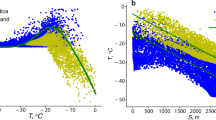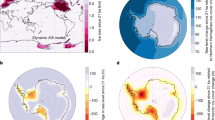Abstract
This study examines the mutual interaction between topographically-forced atmospheric stationary waves and continental-scale ice sheets using a thermomechanical ice-sheet model coupled to a linear as well as a fully-nonlinear dry atmospheric primitive equation model. The focus is on how the stationary-wave induced ablation feeds back on the ice sheet. Simulations are conducted in which an embryonal ice mass, on an idealised “North American” continent, evolves to an equilibrium ice sheet. Under the coupling to the linear atmospheric model, the equilibrium ice sheet is primarily controlled by the ratio between the wavelength of the stationary waves and the zonal continental extent. When this ratio is near two, the ice sheet has its center of mass shifted far eastward and its shape is broadly reminiscent of the Laurentide ice sheet at LGM. For wavelengths comparable to the continental extent, however, the ice margin extends far equatorward on the central continent but is displaced poleward near the eastern coast. Remarkably, the coupling to the nonlinear atmospheric model yields equilibrium ice sheets that are virtually identical to the ones obtained in uncoupled simulations, i.e. a symmetric ice sheet with a zonal southern margin. Thus, the degree of linearity of the atmospheric response should control to what extent topographically-forced stationary waves can reorganise the structure of ice sheets. If the stationary-wave response is linear, the present results suggest that spatial reconstructions of past ice sheets can provide some information on the zonal-mean atmospheric circulation that prevailed.







Similar content being viewed by others
Notes
Because h is an independent variable both Eqs. 1 and 2 are actually linear expressions. However, since the eddy winds are neglected in the mechanical forcing term in essentially all linear stationary-wave models, we follow previous investigations and refer to Eqs. 1 and 2 as the “full” and “linear” forcing, respectively.
For a complete description of T R , the reader is referred to the model’s user guide, which is available at http://www.mi.uni-hamburg.de/puma.
References
Abe-Ouchi A, Segawa T, Saito F (2007) Climatic conditions for modelling the Northern Hemisphere ice sheets throughout the ice age cycle. Clim Past 3:423–438
Berger A (1978) Long-term variations of caloric insolation resulting from the Earth’s orbital elements. Quat Res 9:139–167
Berger A, Loutre MF, Galle H (1998) Sensitivity of the LLN climate model to the astronomical and CO2 forcings over the last 200 ky. Clim Dyn 14:615–629
Bonelli S, Charbit S, Kageyama M, Woillez MN, Ramstein G, Dumas C, Quiquet A (2009) Investigating the evolution of major Northern Hemisphere ice sheets during the last glacial-interglacial cycle. Clim Past 5:329–345
Braithwaite RJ, Oleson OB (1989) Calculation of glacier ablation from air temperature, West Greenland. In: Oerlemans J (eds) Glacier fluctuation and climate change. Kluwer, Dordrecht, pp 219–233
Brandefelt J, Körnich H (2008) Northern Hemisphere stationary waves in future climate projections. J Clim 21:6341–6353
Charbit S, Ritz C, Philippon G, Peyaud V, Kageyama M (2007) Numerical reconstructions of the Northern Hemisphere ice sheets through the last glacial-interglacial cycle. Clim Past 3:15–37
Charney JG, Eliassen A (1949) A numerical method for predicting the perturbations of the middle latitude westerlies. Tellus 1:38–54
Chen S, Trenberth KE (1988) Orographically forced planetary waves in the Northern Hemisphere winter: steady state model with wave-coupled lower boundary formulation. J Atmos Sci 45:657–681
Clark PU, Mix AC (2002) Ice sheet and sea level of the last glacial maximum. Quat Sci Rev 21:1–7
Claussen M, Fohlmeister J, Ganopolski A, Brovkin V (2006) Vegetation dynamics amplifies precessional forcing. Geophys Res Lett 33. doi:10.1029/2006GL026111
CLIMAP: (1984) The last interglacial ocean. Quat Res 21:123–224
Colleoni F (2009) On the Late Saalian glaciation (160–140 ka): a climate modeling study. PhD thesis, Laboratory of Glaciology and Geophysical Environment, Grenoble
Colleoni F, Krinner G, Jakobsson M, Peyaud V, Ritz C (2009) Influence of regional parameters on the surface mass balance of the Eurasian ice sheet during the peak Saalian (140 kya). Glob Planet Change 68:132–148
Colleoni F, Liakka J, Krinner G, Jakobsson M, Masina S, Peyaud V (2010) The sensitivity of the Late Saalian (140 ka) and LGM (21 ka) Eurasian ice sheets to sea surface conditions. Clim Dyn 1–23. doi:10.1007/s00382-010-0870-7
Cook KH, Held IM (1988) Stationary waves of the ice age climate. J Clim 1:807–819
Cook KH, Held IM (1992) The stationary response to large-scale orography in a general circulation model and a linear model. J Atmos Sci 49:525–539
Dyke AS (2004) An outline of North American deglaciation with emphasis on central and northern Canada. In: Ehlers J, Gibbard PL (eds) Quaternary glaciations-extent and chronology, Part II. vol 2b, Elsevier, Amsterdam, pp 373–424
Dyke AS, Andrews JT, Clark PU, England JH, Miller GH, Shaw J, Veillette JJ (2002) The laurentide and innuitian ice sheets during the last glacial maximum. Quat Sci Rev 21(1–3):9–31. doi:10.1016/S0277-3791(01)00095-6
Fraedrich K, Kirk E, Luksch U, Lunkeit F (2005) The Portable University Model of the Atmosphere (PUMA): Storm track dynamics and low frequency variability. Meteorol Zeitschrift 14:735–745
Greve R (1997) Application of a polythermal three-dimensional ice sheet model to the Greenland ice sheet: response to steady-state and transient climate scenarios. J Clim 10:901–918
Greve R, Weis M, Hutter K (1998) Palaeoclimatic evolution and present conditions of the Greenland Ice Sheet in the vicinity of summit: an approach by large-scale modelling. Paleoclimates 2(2–3):133–161
Hall MNJ, Valdes PJ, Dong B (1996) The maintenance of the last great ice sheets: a UGAMP GCM study. J Clim 9:1004–1019
Held IM (1983) Stationary and quasi-stationary eddies in the extratropical troposphere: theory. In: Hoskins B, Pearce R (eds) Large-scale dynamical processes in the atmosphere. Academic Press, San Diego, pp 127–169
Hoskins BJ, Karoly DJ (1981) The steady linear response of a spherical atmosphere to thermal and orographic forcing. J Atmos Sci 38:1179–1196
Hoskins BJ, Simmons AJ (1975) A multi-layer spectral model and the semi-implicit method. Quart J R Meteor Soc 101:637–655
Hutter K (1983) Theoretical glaciology: material science of ice and the mechanics of glaciers and ice sheets. D. Reidel, Dordrecht
James IN, Gray LJ (1986) Concerning the effect of surface drag on the circulation of a baroclinic planetary atmosphere. Quart J R Meteor Soc 112:1231–1250
Justino F, Timmermann A, Merkel U, Souza EP (2005) Synoptic reorganization of atmospheric flow during the last glacial maximum. J Clim 18:2826–2845
Kageyama M, Valdes PJ (2000) Impact of the North American ice-sheet orography on the last glacial maximum eddies and snowfall. Geophys Res Lett 27(10):1515–1518
Kageyama M, Laine A, Abe-Ouchi A, Braconnot P, Cortijo E, Crucifix M, de Vernal A, Guiot J, Hewitt CD, Kitoh A, Kucera M, Marti O, Ohgaito R, Otto-Bliesner B, Peltier WR, Rosell-Mele A, Vettoretti G, Weber SL, Yu Y (2006) Last glacial maximum temperatures over the North Atlantic, Europe and western Siberia: a comparison between PMIP models, MARGO sea-surface temperatures and pollen-based reconstructions. Quat Sci Rev 25(17-18):2082–2102
Källén E, Crafoord C, Ghil M (1979) Free oscillations in a climate model with ice-sheet dynamics. J Clim 36:2292–2303
Kleman J, Fastook J, Stroeven AP (2002) Geologically and geomorphologically constrained numerical model of Laurentide ice sheet inception and build-up. Quat Int 95(6):87–98
Kutzbach JE, Guetter PJ (1986) The influence of changing orbital parameters and surface boundary conditions on simulations for the last 18 000 years. J Atmos Sci 43:1726–1759
Liakka J, Nilsson J (2010) The impact of topographically forced stationary waves on local ice-sheet climate. J Glac 56:534–544
Lindeman M, Oerlemans J (1987) Northern Hemisphere ice sheets and planetary waves: a strong feedback mechanism. J Climatology 7:109–117
Milankovitch M (1930) Mathematische klimalehre und astronomische theorie der klimaschwankungen i. In: Köppen W, Geiger R (eds) Handbuch der klimatologie, Part A. Gebruder Borntreger, Berlin
Oerlemans J (1979) A model of a stochastically driven ice sheet with planetary wave feedback. Tellus 31:469–477
Oerlemans J (1980) Model experiments on the 100,000-yr glacial cycle. Nat Biotechnol 287:430–432
Paul A, Schaefer-Neth C (2003) Modeling the water masses of the atlantic ocean at the Last Glacial Maximum. Paleoceanography 18. doi:10.1029/2002PA000
Peixoto JP, Oort A (1992) The physics of climate. Springer, Berlin
PMIP Participating Groups: (2000) Comparisons of ice-sheet surface mass budgets from Paleoclimate Modeling Intercomparison Project (PMIP) simulations. Glob Planet Change 24:79–106
Ringler TD, Cook KH (1997) Factors controlling nonlinearity in mechanically forced stationary waves over orography. J Atmos Sci 54:2612–2629
Ringler TD, Cook KH (1999) Understanding the seasonality of orographically forced stationary waves: interaction between mechanical and thermal forcing. J Atmos Sci 56:1154–1174
Roe GH (2005) Orographic precipitation. Ann Rev Earth Planet Sci 33:645–671
Roe GH, Lindzen RS (2001) A one-dimensional model for the interaction between continental-scale ice sheets and atmospheric stationary waves. Clim Dyn 17:479–487
Roe GH, Lindzen RS (2001) The mutual interaction between continental-scale ice sheets and atmospheric stationary waves. J Clim 14:1450–1465
Saltzman B, Irsch FE (1972) Note on the theory of topographically forced planetary waves in the atmosphere. Mon Wea Rev 100. doi:10.1175/1520-0493(1972)100
Sanberg JAM, Oerlemans J (1983) Modeling of Pleistocene European ice sheets: the effect of upslope precipitation. Geol Mijnbouw 62:267–273
Shackleton NJ (2000) The 100,000-year ice-age cycle identified and found to lag temperature, carbon dioxide, and orbital eccentricity. Sci Agric 289:1897–1902
Svendsen JI, Alexanderson H, Astakhov VI, Demidov I, Dowdeswell JA, Funder S, Gataullin V, Henriksen M, Hjort C, Houmark-Nielsen M, Hubberten HW, Ingolfsson O, Jakobsson M, Kjaer KH, Larsen E, Lokrantz H, Lunkka JP, Lysa A, Mangerud J, Matiouchkov A, Murray A, Moller P, Niessen F, Nikolskaya O, Polyak L, Saarnisto M, Siegert C, Siegert MJ, Spielhagen RF, Stein R (2004) Late Quaternary ice sheet history of northern Eurasia. Quat Sci Rev 23:1229–1271
Tarasov L, Peltier WR (1997) Terminating the 100 kyr cycle. J Geophys Res 102:21,665–21,693
Ting M (1994) Maintenance of northern summer stationary waves in a GCM. J Atmos Sci 51(22):3286–3308
Trenberth K, Chen S (1988) Planetary waves kinematically forced by Himalayan orography. J Atmos Sci 45:2934–2948
Valdes PJ, Hoskins BJ (1991) Nonlinear orographically forced planetary waves. J Atmos Sci 48:2089–2108
van den Berg J, van de Wal R, Oerlemans J (2008) Mass balance model for the Eurasian ice sheet for the last 120,000 years. Glob Planet Change 61:194–208
Weertman J (1976) Milankovitch solar radiation variations and ice age ice sheet sizes. Nat Biotechnol 261:17–20
Acknowledgments
We thank J. Kleman and two anonymous reviewers for valuable comments on the manuscript. The work reported here was supported by the Swedish Research Council and the Climate Research School at Stockholm University and is a contribution from the Bert Bolin Centre for Climate Research.
Author information
Authors and Affiliations
Corresponding author
Rights and permissions
About this article
Cite this article
Liakka, J., Nilsson, J. & Löfverström, M. Interactions between stationary waves and ice sheets: linear versus nonlinear atmospheric response. Clim Dyn 38, 1249–1262 (2012). https://doi.org/10.1007/s00382-011-1004-6
Received:
Accepted:
Published:
Issue Date:
DOI: https://doi.org/10.1007/s00382-011-1004-6




